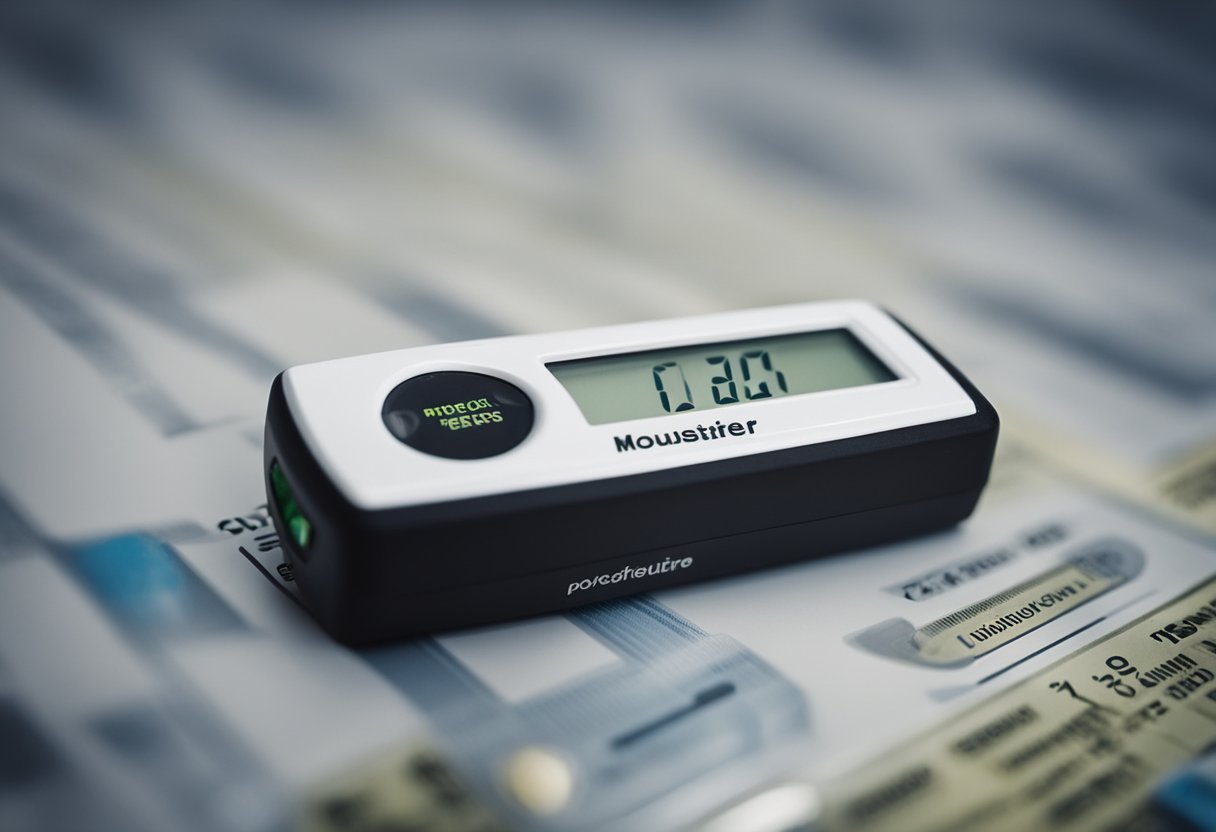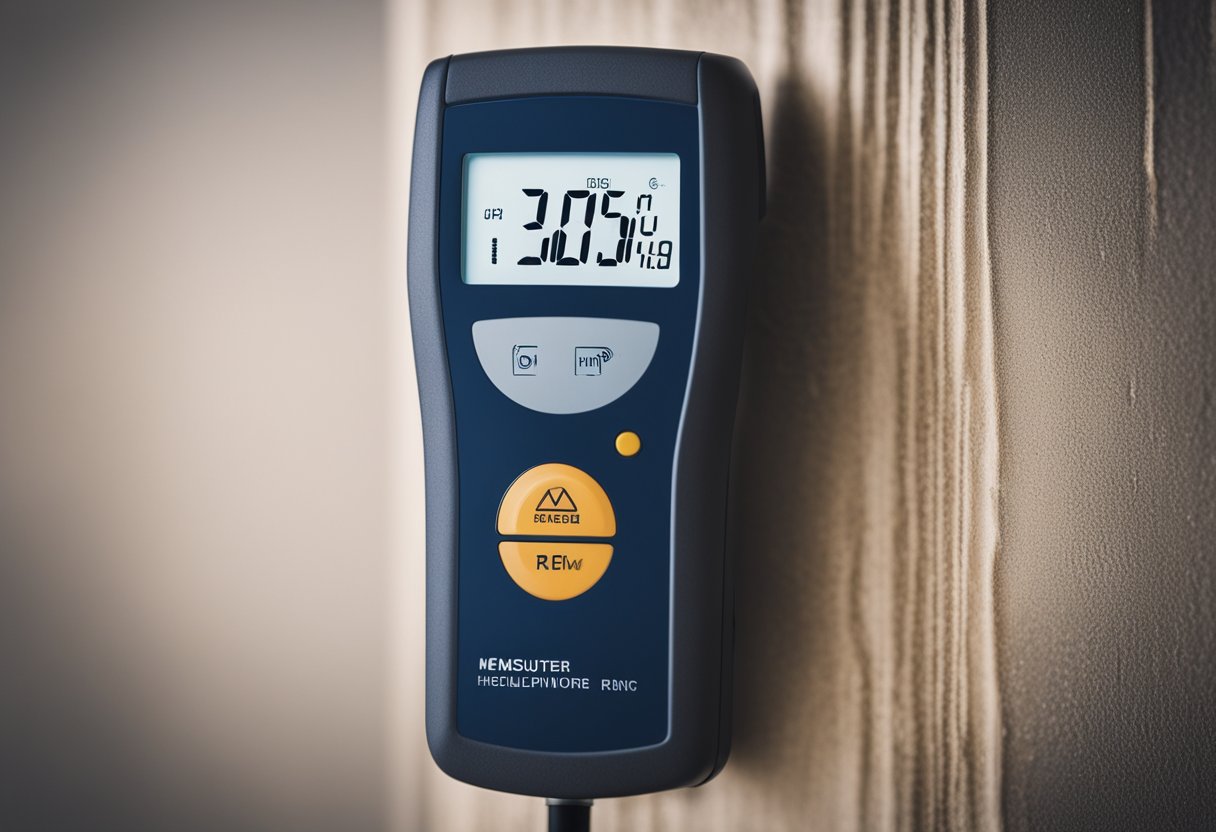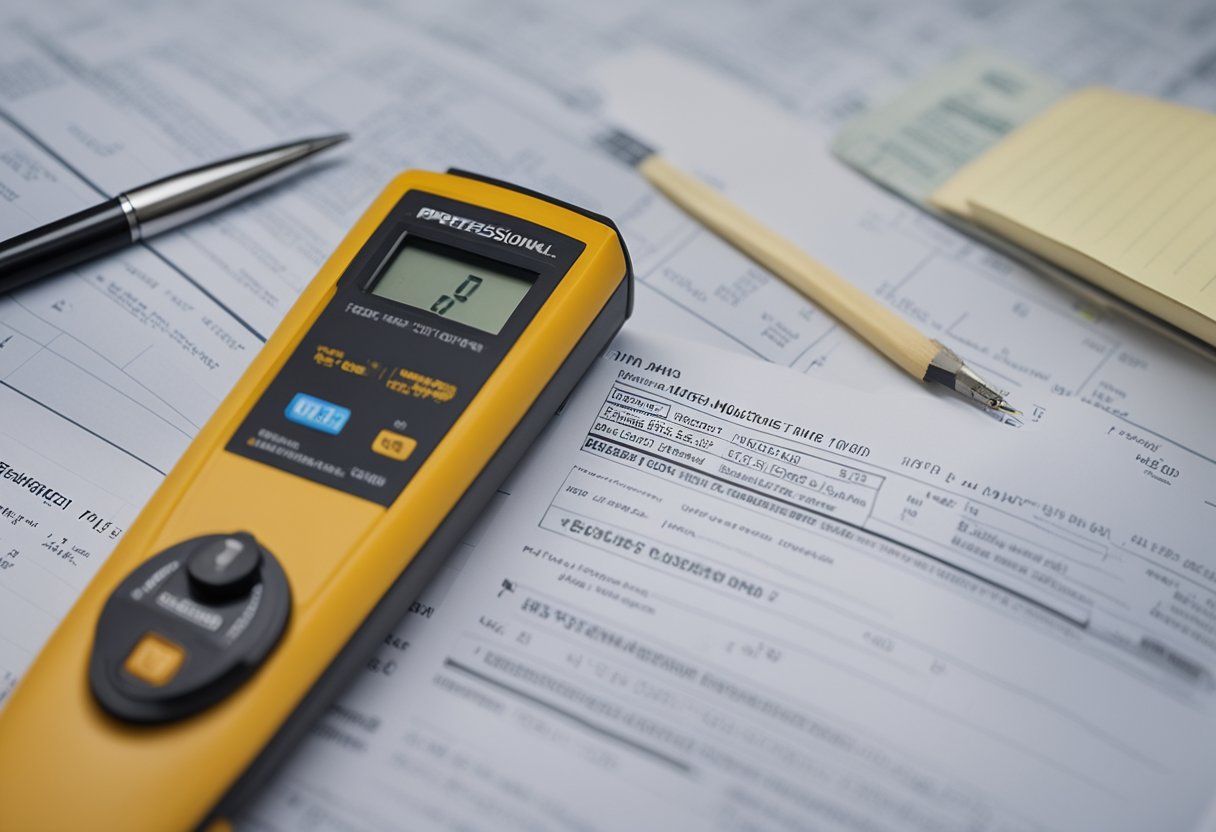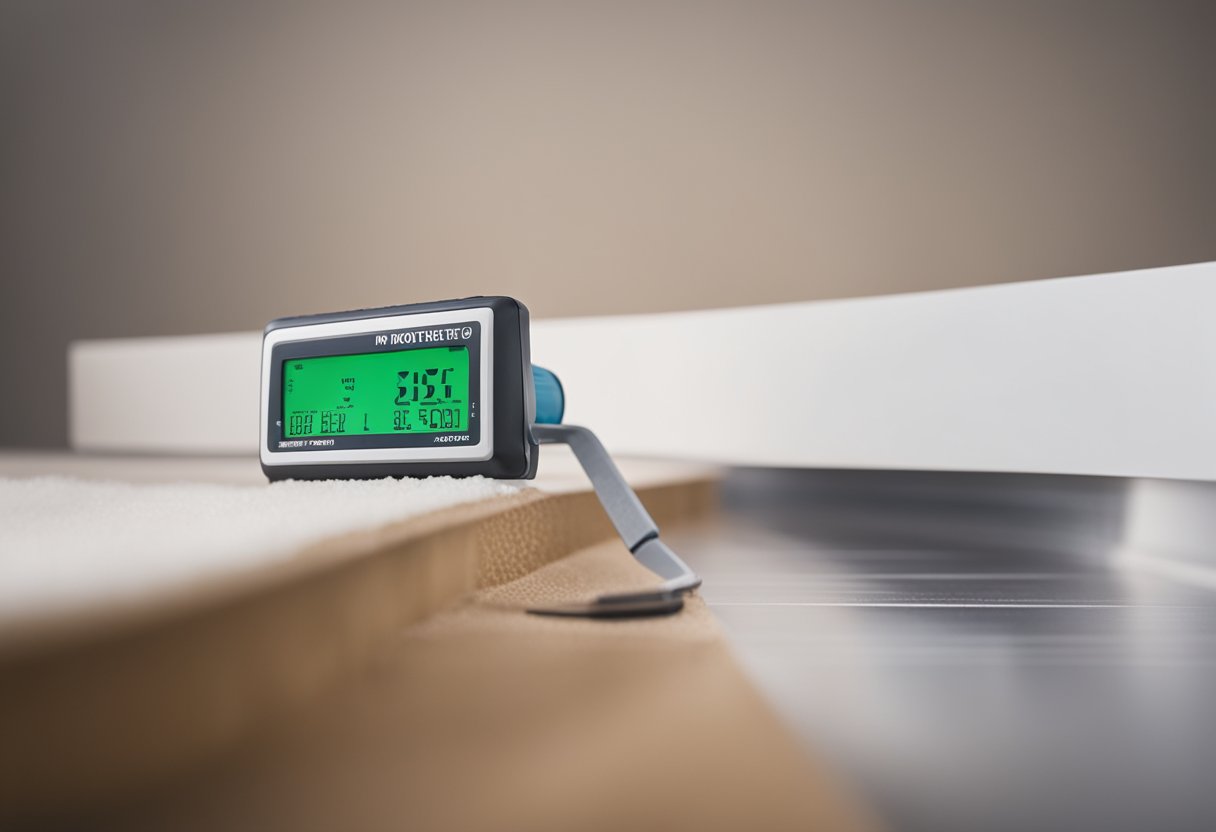Moisture in drywall is a common issue that can lead to significant damage if not addressed promptly. Drywall is a porous material that can absorb moisture from the surrounding environment, leading to swelling, warping, and even mold growth. As such, it is essential to understand how to measure moisture levels in drywall accurately and take steps to prevent and remediate moisture damage.

Measuring moisture levels in drywall requires specialized tools called moisture meters. There are various types of moisture meters available, each with its own advantages and disadvantages. Some meters use pins to penetrate the drywall surface and measure moisture content directly, while others use non-invasive methods such as radiofrequency or capacitance to measure moisture levels without damaging the drywall. Understanding the differences between these meters and selecting the right one for the job is crucial to ensure accurate and reliable moisture readings.
Check out the best moisture readers:
Key Takeaways on Moisture Reading for Drywall
- Moisture in drywall can cause significant damage if not addressed promptly.
- Measuring moisture levels in drywall requires specialized tools called moisture meters.
- Selecting the right type of moisture meter for the job is crucial to ensure accurate and reliable moisture readings.
Understanding Moisture in Drywall
As a professional in the construction industry, I understand the importance of maintaining the integrity of drywall. Moisture is one of the biggest enemies of drywall, and it can cause a lot of damage if not detected and addressed early on.
Moisture in drywall refers to the amount of water present in the material. Moisture content is the percentage of water in drywall by weight. It is important to note that drywall is not completely dry, and it does contain some moisture. The acceptable percentage of moisture for drywall is between 5% and 12% . Anything above this range indicates that the drywall has been exposed to too much humidity and is compromised.
Humidity plays a significant role in the moisture content of drywall. Relative humidity (RH) is the amount of water vapor in the air compared to the maximum amount of water vapor that the air can hold at a specific temperature. Ideally, the RH in a room should be between 30% and 50% for optimal indoor air quality. If the humidity is too high, it can cause moisture to accumulate in the drywall, leading to potential staining and deterioration of its surface. High humidity levels can also encourage mold growth, as mold spores thrive in damp environments.
It is important to check for moisture in drywall before installing or painting it. A moisture meter is a tool that can help pinpoint wet areas in drywall. Even a reading of up to 17% means that the drywall is salvageable, but any moisture level above 17% indicates that the drywall has been compromised and will need to be replaced or cannot be used .
In conclusion, understanding moisture in drywall is crucial for maintaining the integrity of drywall and preventing further damage. By monitoring humidity levels and using a moisture meter to check for wet areas, professionals in the construction industry can ensure that drywall is installed and maintained properly.
Types of Moisture Meters
As a professional contractor, I have used many different types of moisture meters over the years. Moisture meters are an essential tool for any contractor or DIY enthusiast who wants to ensure their drywall is free of moisture. There are two main types of moisture meters: Pin-Type Moisture Meters and Pinless Moisture Meters.
Pin-Type Moisture Meters
Pin-type moisture meters are the most common type of moisture meter used for drywall. These meters use two pins to penetrate the surface of the drywall and measure the moisture content of the material. The pins are inserted into the drywall, and an electrical current is passed through the pins to measure the resistance of the drywall. The resistance is then used to calculate the moisture content of the material.
Pin-type moisture meters are simple to use and provide accurate readings. They are also relatively inexpensive compared to other types of moisture meters. However, they do require you to make holes in the drywall, which can be a problem if you are working on a finished wall.
Pinless Moisture Meters
Pinless moisture meters are a newer type of moisture meter that uses radio frequency to measure the moisture content of the drywall. These meters do not require you to make holes in the drywall, making them ideal for use on finished walls.
Pinless moisture meters work by emitting a radio frequency signal that penetrates the drywall. The signal is then reflected back to the meter, and the moisture content of the material is calculated based on the signal strength.
Pinless moisture meters are more expensive than pin-type moisture meters, but they are more versatile and can be used on finished walls. They are also more accurate than pin-type moisture meters because they do not damage the drywall.
In conclusion, both pin-type and pinless moisture meters are essential tools for anyone working with drywall. Pin-type moisture meters are more affordable, while pinless moisture meters are more versatile. It is up to you to decide which type of moisture meter is best for your needs.
Best humidity sensor:
- HUMIDITY SENSOR: Our handy meter tool can quickly determine what level of remediation is needed to keep your family safe from black mold. High levels of dampness that go untreated are the leading cause of harmful fungus growth in the home.
- WATER LEAK DETECTOR: Finding the moisture content in your wood or drywall is the first step in early prevention. Continuously check and test suspicious water stains around the house so you can determine whether the area is wet or has already dried. Low, medium and high moisture tones and on-screen icons, Reading HOLD button
- MOISTURE READER: The mold test features large 0.3″ high digits in a backlit LCD for quick and easy detecting. Our mildew scanner includes extra 8mm stainless steel pins, a protective cap that doubles as a calibration checker, and a “9V” battery.
- MOLD TESTER: For an accurate test read, stick the stainless steel pins into the surface of what you’re measuring. The gauge has a broad range of 5 – 50% for wood and 1.5 – 33% for building materials such as concrete and drywall.
- GENERAL TOOLS: We’re a recognized leader in designing and developing specialized precision tools dedicated to delivering exceptional customer service. We encourage artisans and DIYers to work smarter, measure better, and repair more productively.
How to Measure Moisture in Drywall
As a professional in the construction industry, I know that moisture can be a major issue when it comes to drywall. Measuring the moisture content of drywall is crucial to ensure that it is not compromised and to prevent mold growth.
To measure the moisture level in drywall, I use a moisture meter. This device is specifically designed to measure moisture in various materials, including drywall. When measuring moisture, it is important to take a baseline reading of a known dry area on the wall. This reading will serve as a reference point for comparing other readings.
When using a moisture meter, it is important to ensure that the device is calibrated correctly and that the probes are inserted into the drywall at different depths (up to 2-4 inches). This will help to get an accurate average of the moisture content.
Drywall is considered to have an appropriate level of moisture if it has a moisture content of between 5 and 12%. Even a reading of up to 17% means that the drywall is salvageable, but any moisture level above 17% tells us that the drywall has been compromised and will need to be replaced.
It is important to note that relative humidity can have some effect on moisture levels, but drywall is considered to have an appropriate level of moisture if it falls within the range of 5 to 12%. It is also important to scan the wall for high-moisture areas, as these areas may need to be addressed before they become a bigger issue.
In conclusion, measuring moisture in drywall is a crucial step in ensuring that it is not compromised and to prevent mold growth. Using a moisture meter and taking a baseline reading of a known dry area on the wall are important steps in measuring moisture accurately.
Effects of Moisture Damage
Moisture damage to drywall can have serious consequences on the structural integrity of a building, as well as the health of its occupants. When drywall absorbs moisture, it can weaken and become soft, leading to potential structural damage.
One of the most common effects of moisture damage in drywall is mold growth. Mold spores thrive in damp environments and can quickly spread throughout a building if not addressed quickly. Moldy walls or moldy drywall is not only unsightly, but can also pose a serious health risk to occupants. Mold can cause respiratory issues, allergic reactions, and other health problems.
Another effect of moisture damage is water damage, which can occur when a leak or other source of water penetrates the drywall. Water damage can cause staining, warping, and other forms of damage to the drywall. If not addressed quickly, water damage can lead to more serious problems such as mold growth and structural damage.
In addition to mold growth and water damage, moisture damage can also cause a musty smell in a building. This odor is often a sign that there is moisture present in the drywall, and may be an indication of a leak or other source of water.
Overall, it is important to address any signs of moisture damage in drywall as soon as possible to prevent further damage and ensure the safety of building occupants. Regular moisture readings can help identify potential issues before they become serious problems.
Restoration and Remediation
When it comes to restoring water-damaged drywall, moisture reading is an essential step in the process. Moisture meters are used to determine the extent of water damage and the level of moisture present in the drywall. This information is crucial as it helps to decide whether the drywall can be salvaged or needs to be replaced.
As a restoration and remediation expert, I have handled numerous water damage cases, and I know how important it is to get accurate moisture readings. Moisture meters come in different types, including pin-type, pinless, and hybrid meters. Each type has its advantages and disadvantages, and choosing the right meter for the job is critical.
Pin-type moisture meters are the most common type and are used to measure the moisture content of the drywall by inserting two pins into the material. The pins penetrate the drywall, and the meter measures the electrical resistance between them. The higher the resistance, the drier the material, and the lower the resistance, the more moisture is present. Pin-type meters are accurate but can leave small holes in the drywall, which may need to be patched.
Pinless moisture meters, on the other hand, use electromagnetic signals to measure the moisture content of the drywall without penetrating the material. They are non-invasive and can cover a larger area quickly. However, they are not as accurate as pin-type meters and may be affected by the presence of metal or other materials.
Hybrid moisture meters combine the features of pin-type and pinless meters and are ideal for measuring moisture in drywall. They can be used as both pin-type and pinless meters, providing accurate readings without damaging the material.
In conclusion, moisture reading is an essential step in the restoration and remediation process for water-damaged drywall. Using the right moisture meter is critical to getting accurate readings and making informed decisions about the repair or replacement of the drywall.
Best Pinless moisture meter
- ✅ PROTECT WORK SURFACES -Pinless moisture meter comes with no pins on, so your walls and projects can be undamaged from pinholes, scuffing and scratching to figure out their moisture levels
- ✅ EASY TO READ AND USE- Moisture meter has Big backlit LCD screen and a 3-color LED bar graph, HOLD button, auto power-off function, out of range alarm and low battery, 9V battery included
- ✅FIRST STEP IN MOLD PREVENTION – by checking suspicious water stains with a moisture tester around the house, You can determine whether the area is wet (a perfect breeding ground for mold),but not tell the mold directly.
- ✘ It reads 0-5% on drywall(gypsum panel) -You are not recommended to make test on drywall, because the density of the drywall is too low to register a reading.(the actual readings will vary based on humidity and density of the material).
- ✅ ➜➜Very Important-TIPS 1: The pinless moisture meter is penetrates up to 0.75inches deep, so wetter materials located below your subject material can also influence the readings, as can metal nails, workbench, your hand, etc.
Prevention and Maintenance

As a homeowner, it is important to take preventive measures to avoid moisture-related problems in your drywall. One of the most common causes of moisture damage is water leaks. Therefore, it is important to inspect your plumbing system regularly and fix any leaks promptly. If you notice any signs of water damage such as discoloration or sagging, it is important to act quickly to prevent further damage.
Another important factor to consider is ventilation. Proper ventilation can help to prevent moisture buildup, which can lead to mold growth and other moisture-related problems. Make sure that your bathroom and kitchen are properly ventilated by installing exhaust fans. You should also ensure that your attic and crawl space are properly ventilated to prevent moisture buildup.
Condensation can also be a problem in areas with high humidity. To prevent condensation, you can use a dehumidifier to reduce the humidity levels in your home. You should also ensure that your air conditioning system is functioning properly and that the filters are clean.
Regular maintenance can also help to prevent moisture-related problems. You should inspect your drywall regularly for signs of moisture damage such as discoloration or sagging. If you notice any signs of damage, it is important to take action promptly to prevent further damage.
In conclusion, preventing moisture-related problems in your drywall requires regular maintenance and preventive measures such as fixing leaks, improving ventilation, and reducing humidity levels. By taking these steps, you can help to ensure that your drywall remains in good condition and free from moisture-related problems.
Professional Tools and Tips

As a professional in the construction industry, I understand the importance of accurate moisture readings for drywall. Moisture meters are essential tools for identifying moisture issues in drywall. One of the most reliable moisture meters in the market is the BD-2100 by Delmhorst. This pin moisture meter has a special drywall scale setting designed to get accurate readings of moisture in drywall as low as 0.1% MC. The BD-2100 is a versatile tool that can also be used to measure moisture in other building materials such as wood, concrete, and insulation.
When using the BD-2100, it is essential to use the right type of electrode for the material being measured. The electrode should be selected based on the thickness of the material and the depth of the moisture being measured. Delmhorst offers a range of electrodes to suit different applications. It is also important to calibrate the moisture meter regularly to ensure accurate readings.
In addition to using the right tools, there are several tips that professionals can follow to ensure accurate moisture readings for drywall. Here are a few:
- Take multiple readings: Moisture levels can vary within a single sheet of drywall, so it is essential to take multiple readings to get an accurate picture of the moisture content.
- Measure at different depths: Moisture can be present at different depths in the drywall. To get an accurate reading, it is important to measure at different depths, especially if you suspect there is moisture deeper in the material.
- Measure in different locations: Moisture can also vary in different locations, so it is important to take readings in different areas of the drywall to get a complete picture of the moisture content.
By following these tips and using the right tools, professionals can ensure accurate moisture readings for drywall and identify moisture issues before they become more significant problems.
Best soil moisture meter
- Reliable and accurate: Sensing probe ensures accurate and instant testing results, matching for both indoor or outdoor use.
- Easy to read: Large and clear dial, including ten scales, plug and read.
- How to use: Simply insert the moisture meter into soil and you’ll get the test result instantly. Help your plants grow healthy and strong.
- Less hurts: Single probe, less hurts to the roots, doesn’t dig up too much soil after test.
- Important tips: 1. Do not use it to test very hard soil 2. Never use it to test water or other liquid. Designed for testing soil only. 3. After use, please wipe clean the probe.
Frequently Asked Questions

What are acceptable moisture levels in drywall?
Acceptable moisture levels in drywall are typically between 5% and 12% 1. Moisture levels up to 17% may still be salvageable, but anything above that indicates that the drywall has been compromised and will need to be replaced 2.
How do I determine the moisture content in drywall?
To determine the moisture content in drywall, you will need a moisture meter. There are two types of moisture meters: pin-type and pinless. Pin-type meters use two metal probes that are inserted into the drywall to measure the moisture content, while pinless meters use a sensor that is placed on the surface of the drywall 3.
What is the best moisture meter for measuring drywall moisture?
The best moisture meter for measuring drywall moisture will depend on your specific needs. Pin-type meters are generally more accurate than pinless meters, but they can also cause damage to the drywall. Some popular moisture meter brands include Delmhorst, Protimeter, and Wagner 3.
What are some common causes of high moisture readings in drywall?
Common causes of high moisture readings in drywall include water leaks, floods, high humidity levels, and poor ventilation 2. It is important to address the source of the moisture before attempting to repair or replace the drywall.
How can I prevent false moisture meter readings in drywall?
To prevent false moisture meter readings in drywall, make sure that the drywall is clean and free of debris before taking a reading. You should also avoid taking readings near metal objects, as these can interfere with the meter’s accuracy 1.
At what point should drywall be removed due to moisture damage?
Drywall should be removed if the moisture content is above 17%, or if there is visible mold growth or structural damage 2. It is important to address moisture issues as soon as possible to prevent further damage to the drywall and potential health hazards from mold growth.
Check out the best moisture readers:

Hi, I’m Sal Muller of Tooltrip.com. My DIY experience led me to understand essential power tools for home projects. Tooltrip.com guides enthusiasts and professionals in choosing right tools for any job. I provide concise top tool reviews for easier, efficient DIY.




